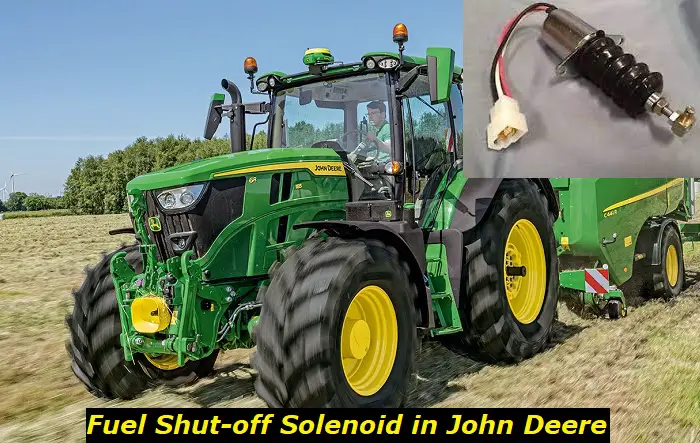John Deere Fuel Shut Off Solenoid Problems. Troubleshooting & Maintenance
The John Deere Fuel Shut Off Solenoid is a critical component in the functioning of heavy-duty John Deere machinery. This solenoid plays a vital role in regulating the fuel flow within the engine system. A well-functioning solenoid ensures smooth operation of the vehicle, while a faulty one can cause a cascade of issues, impacting overall machine performance.

In this article, we will discuss some of the common problems associated with the John Deere Fuel Shut Off Solenoid, exploring their causes, and providing a meticulous guide to troubleshooting solenoid issues. We will also provide professional tips that will help prevent these problems from recurring, ensuring optimal performance and extending the lifespan of your machinery.
Common Problems with John Deere Fuel Shut Off Solenoid
Understanding the complexities of machinery like that of John Deere involves a keen eye for detail. As a proficient mechanic, I have come across a myriad of issues concerning the John Deere Fuel Shut Off Solenoid. Let's delve into some of the common problems that you might encounter.
The principal issue that plagues this solenoid revolves around its inability to cease the fuel supply, often resulting in the engine running continuously or not shutting off when needed. This tends to happen when the solenoid is stuck in an open position. Being unable to control fuel flow can lead to inconvenient and potentially hazardous situations.
Another commonly encountered difficulty involves the solenoid failing to allow requisite fuel flow, obstructing the smooth operation of the engine. You may find your John Deere stuttering to life or not starting at all. Such symptoms usually point towards the solenoid being stuck in a closed position, often attributable to dirt accumulation or wearing out of the spring mechanism within the solenoid.
Further issues consist of erratic engine behavior, such as fluctuating power levels or sudden stalling. These can be both annoying and dangerous, particularly if the machinery is in use. In most cases, these problems signify an intermittent or sporadic functioning of the solenoid, impeding the consistency of fuel supply to the engine.
All of these troublesome situations are indicative of a malfunctioning Fuel Shut Off Solenoid. Nonetheless, the best course of action is never to disregard these signs. Timely recognition and rectification of these problems can prevent extensive damage to your John Deere machinery, saving you both time and hefty repair costs in the long run.
Uncovering the Root Causes of John Deere Fuel Shut Off Solenoid Problems
Working out the root of problems with your John Deere Fuel Shut Off Solenoid can be a daunting task, but breaking down possible causes one by one, it becomes clearer and easier to manage.
Principally, fuel shut off solenoid problems primarily stem from electrical issues or fuel system irregularities. An improper electrical connection or a worn-out wire can prevent the solenoid from receiving the essential power it needs to function effectively. Correspondingly, if the solenoid coil is damaged or the solenoid itself is stuck, it may fail to close or open properly, affecting the fuel flow in the system.
Equally, fuel system issues can also play a significant role in causing trouble with your solenoid. For instance, if the fuel filter is clogged, it can lead to an insufficient fuel supply, causing the solenoid to malfunction.
In addition, external issues such as corrosion can impair solenoid functionality. Over time, the solenoid can succumb to rust or corrosion, impacting its efficiency and operability. Even the smallest amount of dirt or grime can lodge within the solenoid, preventing it from working as it should.
Remember, understanding these causes is the first crucial step towards effective troubleshooting and problem-solving. Thorough knowledge of these underlying causes will enable you to conduct more effective repairs and preventive maintenance to prolong the life of your John Deere machinery.
Step-by-Step Guide to Troubleshooting the Solenoid
Whenever you encounter issues with your John Deere fuel shut off solenoid, it's essential to approach the situation methodically. Experiencing difficulties with heavy machinery can be intimidating, but armed with the right knowledge, you can tackle the problem head-on. Remember, safety should always be your priority. Before you begin troubleshooting, ensure that the machinery is properly switched off and cool to avoid any inadvertent accidents.
Begin the troubleshooting process by inspecting the solenoid for any visible signs of damage. Cracks, burns, or signs of extreme wear can signify a physically damaged solenoid. If you spot any such signs, replacing the solenoid is likely the most viable solution. However, not all problems are visible to the naked eye. In cases where there's no obvious physical damage, you'll need to delve deeper into the potential mechanical issues.
Start by testing the solenoid's electrical operation. With the help of a multimeter, check for electricity's presence at the solenoid while trying to start the machine. If electricity is present and the machine is not starting, it's likely a defective solenoid. For solenoids with a manual lever, try manually opening the fuel path. If the engine starts under manual operation but not under electrically automated operation, it indicates that the solenoid is indeed the culprit.
Another effective way to diagnose solenoid problems is by conducting a continuity test. If the multimeter shows zero resistance when attached to the solenoid leads, it means the internal coil is conducting electricity, indicating a working solenoid. No electric flow could represent a burnt or otherwise damaged coil, which means the solenoid needs replacement.
Navigating these tests can be challenging, but by approaching each step with diligence and patience, you can accurately diagnose and pave the way for resolving issues with the John Deere Fuel Shut Off Solenoid.
Professional Tips to Prevent Future Problems
Maintenance holds the key to longevity and optimal performance when it comes to machinery like your John Deere equipment. The Fuel Shut Off Solenoid is no different. Frequent checkups and preventive measures can save you from unexpected halts and unnecessary expenses.
Let's talk about some tried and true ways to keep solenoid problems at bay. A well-lubricated fuel system is the lifeline of your machinery. Regularly cleaning and lubricating the fuel system, including the Fuel Shut Off Solenoid, can dramatically decrease the chances of facing common issues.
Another tip in the maintenance playbook is to not wait for symptoms or breakdown before replacing worn-out components. If the Fuel Shut-Off Solenoid has served its expected lifespan or is showing signs of wear, get it replaced proactively. That calls for regular inspection of your machinery, particularly paying attention to the fuel system and the solenoids incorporated within it.
Additionally, always make sure to use genuine and high-quality replacement parts for your John Deere equipment. Low-grade components may seem to save you money in the short-run, but in my experience, they tend to fail prematurely, possibly damaging other interconnected parts.
Incorporating these preventive measures into your maintenance routine will go a long way in ensuring that your John Deere machinery operates optimally for years to come.

Add comment